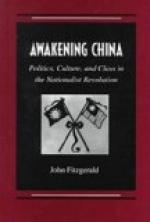Instead of filling the long interval between the creation of the world and the birth of history with gods and fairies, the Chinese cover that period by three sovereigns whom they call after their favourite triad, heaven, earth, and man, giving them the respective titles Tien-hwang, Ti-hwang, and Jin-hwang. Each of these reigned eighteen thousand years; but what they reigned over is not apparent. At all events they seem to have contributed little to the comfort of their people; for at the close of that long period the wretched inhabitants of the empire—the only country then known to exist on earth—had no houses, no clothes, no laws, and no letters.
Now come five personages who, in accordance with Chinese historical propriety, are likewise invested with imperial dignity and are called Wu-ti, “the five rulers.” Collectively they represent the first appearance of the useful arts, the rude beginnings of human civilisation. One of these rulers, noticing that birds constructed nests, taught his people to build huts, from which he is called the “nest builder.” Another was the Prometheus of his day and obtained fire, not, however, by stealing it from the sun, but by [Page 72] honestly working for it with two pieces of wood which he rubbed together. The third of these rulers, named Fuhi, appears to have been the teacher of his people in the art of rearing domestic animals; in other words, the initiator of pastoral life, and possibly the originator of sacrificial offerings. The fourth in order introduced husbandry. As has been stated in a previous chapter (see page 36), he has no name except Shin-nung, “divine husbandman”; and under that title he continues to be worshipped at the present day as the Ceres of China. The Emperor every spring repairs to his temple to plough a few furrows by way of encouragement to his people. The last of the five personages is called the “yellow ruler,” whether from the colour of his robes, or as ruler of the yellow race, is left in doubt. He is credited with the invention of letters and the cycle of sixty years, the foundation of Chinese chronology (2700 B. C.).




